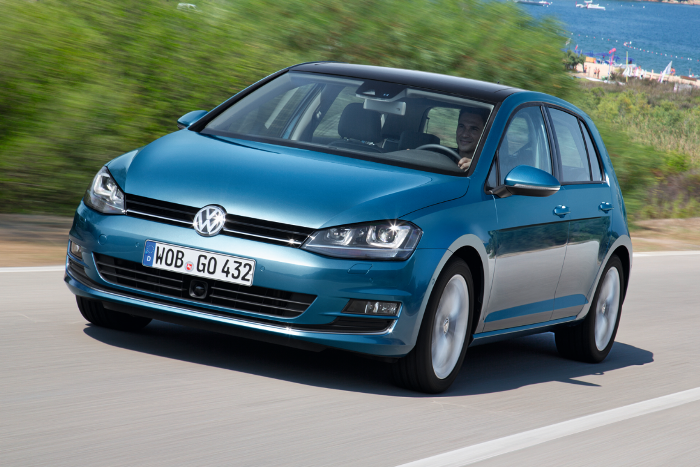
Car reviews
Read our expert car reviews - where we give insight into the latest vehicles to hit our roads.
15 April 2013
Volkswagen have made no secret that they aim to be the world’s number 1 car maker by 2018, but being at the top of the sales volume ladder takes more than just building nice looking cars that are enjoyable to drive. Let’s face it, no matter how good a product is, buyers won’t even go near the showroom if the price ain’t right.

“Benchmark” is a word that’s been much overused in motoring circles. So is the term “game-changer”. More often than not, those cars described as benchmarks are nothing more than also-rans and cars that we’ve been told are game-changers have made no change at all. Well, not usually.
But coming from Volkswagen when referring to their new Golf VII, those cheesy words start to have some meaning.
Volkswagen have made no secret that they aim to be the world’s number 1 car maker by 2018, but being at the top of the sales volume ladder takes more than just building nice looking cars that are enjoyable to drive. Let’s face it, no matter how good a product is, buyers won’t even go near the showroom if the price ain’t right.
New Zealand buyers are offered two 1.4 litre TSI petrol engine options, with outputs of 90kW/200Nm and 103kW/250Nm, as well as a pair of diesels; a 77kW/250Nm 1.6 litre TDI or a 110kW/320Nm 2.0 litre TDI.
With prices starting at just $32,250, the Golf is cheaper than an entry level Corolla, Civic, Mazda3, i30 or just about every compact hatchback you care to mention. For that money, you’ll get a six speed manual; automatic models start at $34,750, with all having a seven speed DSG transmission with the exception of the 2.0 TDI, which has a six speed unit.
All engines are lively enough and come complete with Volkswagen’s BlueMotion fuel-saving features, with emission and fuel consumption figures among the best in the business. The thirstiest car in the range is the TSI manual, with a claimed combined cycle consumption of 5.2L/100km and emissions of 120g/km.
Two impressive levels of specification are available in our market, with the 90kW TSI and 77kW TDI offered in Comfortline spec and the 103kW TSI and 110kW TDI having the premium Highline equipment level.
Soft touch, high quality materials are used throughout, and even at entry level, the Golf offers the look, feel and cabin ambience of a premium quality car. A 5.8 inch colour touch screen, Bluetooth, Media Device Interface (MDI), cruise control with limiter function, alloy wheels, tyre pressure warning, fuel-filler neck to protect against use of wrong fuel, climate air-conditioning and XDS Electronic Diff Lock are all standard fare across the range.
All models have engine stop/start, meet Euro 5 emission standards and naturally, have a 5 star Euro NCAP safety rating. Safety systems include ISOFIX child seat mounts, Multi-collision Brake (a feature which applies the brakes after a collision to prevent or minimise the severity of subsequent collisions), the usual array of airbags including a driver’s knee ‘bag, ESP and a raft of other active safety features.
From a styling perspective, like most of its predecessors have been in the past, visually the Golf VII could be described as more evolutionary than revolutionary when compared against the model it replaces. But under the sleeker looking skin, everything is new.
It’s based on Volkswagen’s new MBQ platform, which is designed to be stretched and tweaked for use on numerous future products, with the common part of the platform being based around the firewall, running from front strut towers back to the front floor area. This concept allows for quicker new product development and keeps development and production costs down.
The wheelbase has been lengthened by 59mm, providing more rear seat passenger legroom and the luggage compartment offers a fairly respectable 380 litres with the seats folded up or 1,452 litres with the seats folded down.
The Highline models provide a few added luxuries such as larger, 17 inch alloys, park pilot front and rear, a reversing camera and SAT-Nav, rain sensing wipers and an upgraded automatic lighting package called “Light & Sight”. But while the entry level price tag is bound to be a huge attraction, the Highline models offer a lot of kit for a sharp price too.
So, diesel or petrol? While the torque of the Highline TDI provides punchy off-the-line performance, at 8.4 seconds the petrol is 0.2 seconds quicker to 100km/h than the diesel. And with a claimed 5.0L/100km fuel consumption figure for the petrol model, against the diesel’s 4.4L/100km, fuel economy is still frugal and there’s no RUC to pay with petrol. At $43,750, the top shelf diesel model is $4k more than the equivalent spec petrol’s $39,750 price tag, so the petrol starts to look like the more attractive option.
Whichever model you choose, our bet is that the Golf is set to be included on more shopping lists than ever before. You could say that this benchmark hatchback is set to be a real game-changer.